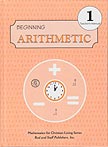









This course is designed to start at the beginning of the first grade. 170 lessons are bound in two workbook with 1 tear-out sheet for each lesson. No unit or chapter divisions are given. Money, measures, place value, fractions, and so forth are taught throughout the year while addition and subtraction facts are being drilled.
A small tablet of 72 speed drills provides timed practice of addition and subtractions facts. These drills begin at lesson 28 and continue through lesson 170. Speed drills are to be given every other day. Directions for using this tablet are on page 6 of the teacher's manual.
One hardcover teacher's manual covers the whole course. The preliminary information in the beginning should be thoroughly read so you understand exactly where you are going. This manual is essential for the course. Directions are given to guide the teacher in class time to assure that important concepts are taught and drilled. A reduced copy of the pupil's lesson is included with answers filled in.
In the Teacher's Manual, each lesson is outlined under three main headings: Preparation, Class Time, and Follow-up.
Preparation lists the things to do before school in the morning. Gather the materials that are listed. Put the chalkboard samples on the board. The notation with each one tells at what point you will use it in class time.
Class Time outlines your teaching session with numbered points. These points generally begin with review drills and move on to new concepts and preparation for the workbook assignment. Bold print is to be spoken by the teacher or recited with the class. The last point is always the assignment of the lesson.
Follow-up gives further practice which may be done in various parts of the day. Do the drill activities after the children have finished their workbook pages or in another part of the day. Many of them are little activities that can put odd minutes to constructive use, perhaps even lunchtime.
As the children become accustomed to school and math, you may have them do the practice sheets independently. The papers for each day could be put in a designated place for each child to take and complete according to his ability. Encourage the goal of finishing all the papers each day. A vigorous arithmetic program is valuable for several reasons. Thoroughly learned basics will be a lifelong benefit. And the habit of industrious diligence will be a character blessing as well as academic advantage.
Many lessons in the Teacher's Manual include brief selections from the Bible placed there for your personal inspiration. As you find it suitable, you may share these bits with the children as you teach them arithmetic. You may find them a source of ideas for the devotional period.
Two workbooks contain the pupil lessons for the entier course. Each lesson uses two facing pages. The workbook is not intended to be used in the class session. If you follow the steps in Class Time, the children should be able to do the workbook lesson with the very minimal direction from the teacher. Workbook exercises repeat and reinforce what they have been doing in class.
A separate tablet contains printed drills for every other lesson from Lesson 28 to the end of the course. Doing the speed drill is the next to last point in Class Time on those days. Distribute the drills, and have the children write their names on the line; then have them wait for the signal to start before they turn the paper over.
Time their work for one minute, then say, "If you are not finished, circle the problem you are doing now, then finish." Have each child immediately bring his completed drill to you. Check it and have him practice any facts he had wrong, using the boxes on the other side of the sheet As an aid to speeding checking, the facts are arranged to produce patterns in the answers.
This practice is provided in the form of reproducible worksheets to allow the teacher to tailor the amount of work to the needs and ability of the class. Each lesson lists recommended practice sheets ffor that day in the Follow-up section of the Teacher's Manual.
Most important are the ones in the middle of the list coded with a black circle. The first ones, marked with an open square, are more fundamental, and should be done first if the students are doing them all. The last ones, marked with an open diamond, are extra activities for challenge or interest. These should be kept for last. Since the slower students might rarely have the pleasure of doing these, try to provide occasional opportunity for them to do the extras too.
The Practice Sheets are categorized by skill. The list for each day in the Teacher's Manual names the skill and the number of that worksheet within that skill category. On the practice sheet itself, the lesson number is given in the oval at the top of the page.
These numbers correspond to the recommended listing in the Teacher's Manual, but practice sheets are intended to be flexible. Use them according to your best purposes.
Some frequently used practice sheets are called Forms, they are distinguished by capital letters.
The 208 flash cards for this course are intended only for Grade 1. Addition and subtraction facts extend through sums and minuends of ten. Other categories supply the cards needed for drills in Class Time or Follow-up of the daily lesson plans.
The 9 categories of cards are:
Click on a book to see sample pages.
.jpg)
.jpg)
.jpg)
.jpg)
.jpg)
Click on a book to see sample pages.
| This site is operated by Milestone Books. We are an independent vendor of materials by Rod and Staff Publishers of Crockett, KY. The samples on this site are taken from copyrighted materials, and are shown for information purposes only. |